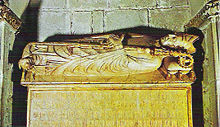
Berenguer de Palou II
Encyclopedia

James I of Aragon
James I the Conqueror was the King of Aragon, Count of Barcelona, and Lord of Montpellier from 1213 to 1276...
.
He began his career as a canon priest in Barcelona Cathedral during the episcopate of his uncle Berenguer de Palou I. Shortly after being elected bishop in 1212, he marched with Peter II of Aragon
Peter II of Aragon
Peter II the Catholic was the King of Aragon and Count of Barcelona from 1196 to 1213.He was the son of Alfonso II of Aragon and Sancha of Castile...
on the latter’s crusade against the Almohads in the Battle of Las Navas de Tolosa
Battle of Las Navas de Tolosa
The Battle of Las Navas de Tolosa, known in Arab history as the Battle of Al-Uqab , took place on 16 July 1212 and was an important turning point in the Reconquista and in the medieval history of Spain...
. Later Palou served as royal councilor and chancellor of the Crown of Catalonia-Aragon.
In 1219, he participated in the Fifth Crusade
Fifth Crusade
The Fifth Crusade was an attempt to reacquire Jerusalem and the rest of the Holy Land by first conquering the powerful Ayyubid state in Egypt....
against Damietta
Damietta
Damietta , also known as Damiata, or Domyat, is a port and the capital of the Damietta Governorate in Egypt. It is located at the intersection between the Mediterranean Sea and the Nile, about north of Cairo.-History:...
in Egypt
Egypt
Egypt , officially the Arab Republic of Egypt, Arabic: , is a country mainly in North Africa, with the Sinai Peninsula forming a land bridge in Southwest Asia. Egypt is thus a transcontinental country, and a major power in Africa, the Mediterranean Basin, the Middle East and the Muslim world...
, contributing to the effort 50 knights and peons and unsuccessfully attempted to prevent the Cathar Crusade.
He founded various establishments for the destitute, offering the Castle of Aviñón del Penedés and some of his own properties for this effort. He supported the founding of the Mercedarian Order in 1218. Bishop Berenguer de Palou gave Peter Nolasco and his companions the white habit that they would wear as characteristic of the Order; he gave them the Rule of Saint Augustine as a norm for their life in common and he gave his authorization for the sign of his cathedral, the Holy Cross, to be on the habit of the Order. After that, Peter Nolasco and the first Mercedarians made their religious profession before the bishop.
In 1219, Bishop Berenguer also supported the introduction into Barcelona
Barcelona
Barcelona is the second largest city in Spain after Madrid, and the capital of Catalonia, with a population of 1,621,537 within its administrative limits on a land area of...
of the Dominican
Dominican Order
The Order of Preachers , after the 15th century more commonly known as the Dominican Order or Dominicans, is a Catholic religious order founded by Saint Dominic and approved by Pope Honorius III on 22 December 1216 in France...
and Franciscan Orders.
In 1225, he accompanied James I on the unsuccessful attack on Peñíscola
Peñíscola
Peníscola or Peñíscola is a municipality in the province of Castellón, Valencian Community, Spain. The town is located on the Costa del Azahar, north of the Serra d'Irta along the Mediterranean coast...
, Valencia
Valencia (province)
Valencia or València is a province of Spain, in the central part of the Valencian Community.It is bordered by the provinces of Alicante, Albacete, Cuenca, Teruel, Castellón, and the Mediterranean Sea...
.
Together they planned the invasion of Mallorca
Mallorca
Majorca or Mallorca is an island located in the Mediterranean Sea, one of the Balearic Islands.The capital of the island, Palma, is also the capital of the autonomous community of the Balearic Islands. The Cabrera Archipelago is administratively grouped with Majorca...
, to which he contributed 99 knights and 1,000 foot soldiers. As a reward, he received 875 knighthood lands and 8 windmills, which had originally been the possession of the barony of Andratx. During the military operations against the Muslims of Mallorca, he was wounded, his foot being mutilated during the last campaign against the Muslims of this island.
In 1233, he was elected Archbishop of Tarragona, but Pope Gregory IX
Pope Gregory IX
Pope Gregory IX, born Ugolino di Conti, was pope from March 19, 1227 to August 22, 1241.The successor of Pope Honorius III , he fully inherited the traditions of Pope Gregory VII and of his uncle Pope Innocent III , and zealously continued their policy of Papal supremacy.-Early life:Ugolino was...
did not approve the election, and Palou did not occupy this see
Episcopal See
An episcopal see is, in the original sense, the official seat of a bishop. This seat, which is also referred to as the bishop's cathedra, is placed in the bishop's principal church, which is therefore called the bishop's cathedral...
.
In 1237, he helped found the Monastery of Santa Clara
Clare of Assisi
Clare of Assisi , born Chiara Offreduccio, is an Italian saint and one of the first followers of Saint Francis of Assisi...
in Barcelona
Barcelona
Barcelona is the second largest city in Spain after Madrid, and the capital of Catalonia, with a population of 1,621,537 within its administrative limits on a land area of...
.

Dénia
Dénia is a city in the province of Alicante, Spain, on the Costa Blanca halfway between Alicante and Valencia, the judicial seat of the comarca of Marina Alta...
. He received various estates as a result and the Seignory
Seignory
In English law, Seignory or seigniory , the lordship remaining to a grantor after the grant of an estate in fee simple....
of Almonesir.
He died in 1241, and his sepulcher can be found in the cathedral of Barcelona.

